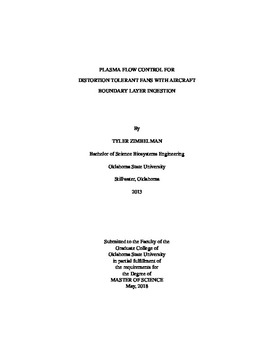| dc.contributor.advisor | Rouser, Kurt P. | |
| dc.contributor.author | Zimbelman, Tyler | |
| dc.date.accessioned | 2019-03-29T15:39:55Z | |
| dc.date.available | 2019-03-29T15:39:55Z | |
| dc.date.issued | 2018-05-01 | |
| dc.identifier.uri | https://hdl.handle.net/11244/317808 | |
| dc.description.abstract | Recent efforts to reduce commercial transport aircraft drag include embedding an aft-mounted engine into the airframe in order to fill the vehicle wake with engine exhaust, consequently reducing fuel consumption. Embedded engines can provide substantial improvements compared to conventional wing-mounted engines by generating thrust with lower-momentum boundary layer ingestion; however, the propulsion system must be capable of performing effectively in a highly distorted flow field. An active flow control technique for reducing distorted boundary layer flow entering an embedded duct is evaluated. Plasma flow control is proposed to reduce flow field distortion. Plasma actuators have previously demonstrated capability to manipulate boundary layer growth by imparting a body force on the flow near the surface, increasing momentum. Multiple variables were evaluated in this study to determine potential flow field improvement, including actuator location, frequency, and power input. Tests were conducted in a low-speed, open-loop wind tunnel with a traverse-mounted pitot-static probe to determine dynamic pressure at an embedded duct exit plane. A single-dielectric-barrier-discharge plasma actuator was tested over a range of wind tunnel speeds at different locations relative to an embedded duct inlet. The local operating Reynolds number due to ramp surface length ranged from 1 to 3 million. The test article was a notional boundary layer ingestion ramp and contraction duct having a 1.25:1 area contraction ratio and 10-inch circular, exit diameter. The duct geometry was a modified NACA 0012 airfoil, and the plasma actuator consisted of two copper electrodes separated by a 0.024-inch thick Mica dielectric barrier. A non-dimensional distortion intensity coefficient was used to evaluate plasma actuator performance. Furthermore, qualitative assessments of velocity contour plots are presented. Results reveal the effectiveness of plasma flow control to manipulate distortion intensity. | |
| dc.format | application/pdf | |
| dc.language | en_US | |
| dc.rights | Copyright is held by the author who has granted the Oklahoma State University Library the non-exclusive right to share this material in its institutional repository. Contact Digital Library Services at lib-dls@okstate.edu or 405-744-9161 for the permission policy on the use, reproduction or distribution of this material. | |
| dc.title | Plasma Flow Control for Distortion Tolerant Fans with Aircraft Boundary Layer Ingestion | |
| dc.contributor.committeeMember | Jacob, Jamey Darin | |
| dc.contributor.committeeMember | Gaeta, Richard Joseph | |
| osu.filename | Zimbelman_okstate_0664M_15747.pdf | |
| osu.accesstype | Open Access | |
| dc.description.department | Mechanical and Aerospace Engineering | |
| dc.type.genre | Thesis | |
| dc.type.material | text | |
